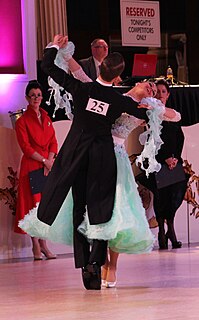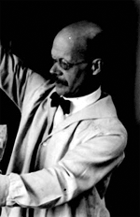In some types of partner dance, lead and follow are designations for the two dancers comprising a dance couple. In the case of mixed-sex couples, the male is traditionally the Lead and the female is the Follow. The Lead is responsible for guiding the couple and initiating transitions to different dance steps and, in improvised dances, for choosing the dance steps to perform. The Lead communicates choices to the Follow and directs the Follow by means of subtle physical and visual signals, thereby allowing the couple to be smoothly coordinated.
The Balboa is a swing dance that originated in Southern California during the 1920s and enjoyed huge popularity during the 1930s and 1940s. The term Balboa originally referred to a dance characterized by its close embrace and full body connection. It emphasizes rhythmic weight shifts and lead-follow partnership. Different dancers in the same region at the same time also danced "swing," a dance characterized by twists, turns, and open-position movement. Over time, these two dances merged and became collectively known as Balboa. The original Balboa dance is now referred to as Pure Balboa, and the original "Swing" dance is now referred to as Bal-Swing or L.A. Swing to differentiate it from other types of swing. Because of its emphasis on subtlety and partnering rather than flashy tricks, Balboa is considered more of a "dancer's dance" than a "spectator's dance."
The schottische is a partnered country dance that apparently originated in Bohemia. It was popular in Victorian era ballrooms as a part of the Bohemian folk-dance craze and left its traces in folk music of countries such as Argentina, Finland ("jenkka"), France, Italy, Norway ("reinlender"), Portugal and Brazil, Spain (chotis), Sweden, Denmark ("schottis"), Mexico, and the United States, among other nations. The schottische is considered by The Oxford Companion to Music to be a kind of slower polka, with continental-European origin.
This is a list of dance terms that are not names of dances or types of dances. See List of dances and List of dance style categories for those.
Because ballet became formalized in France, a significant part of ballet terminology is in the French language.
The Grapevine is a dance figure in partner dancing that shares a common appearance, with some variation, in ballroom, club, and folk dances. It includes side steps and steps across the support foot. The step is used, for example, in the foxtrot, polka, Electric Slide and hustle as well as in freestyle aerobics.

The Walking Boston, sometimes designated the One Step Waltz, is a very simple dance in which many graceful figures may be introduced. It is done to the same music as the Hesitation Waltz and Dream Waltz.

The cha-cha-chá, informally called cha-cha, is a dance of Cuban origin. It is danced to the music of the same name introduced by Cuban composer and violinist Enrique Jorrin in the early 1950s. This rhythm was developed from the danzón-mambo. The name of the dance is an onomatopoeia derived from the shuffling sound of the dancers' feet when they dance the three consecutive quick steps that characterize the dance.
The country/western two-step, often called the "Texas two-step" or simply the "two-step," is a country/western dance usually danced to country music in common time. "Tradtitional [Texas] two-step developed, my theory goes, because it is suited to fiddle and guitar music played two-four time with a firm beat [found in country music]. One-two, one-two, slide-shuffle."
The Texas two-step is the same step known to ballroom dancers as the international fox-trot. Except for the one-step, which is just that, most Texas dances are variations of a two-step, also called a half-step, which is simply a step-close-step. The Texas two-step is generally done with two long steps and a step-close-step to two-four time. Speeded up, it's a shuffle or double shuffle, but still a two-step.
Glide step is a form of movement used by marching bands to minimize upper body movement, enabling musicians to play their instruments and march without air-stream interruptions. Standardizing the style of marching also serves to add to the visual effect of a marching band. Sometimes special shoes are worn with a curved heel that facilitates rolling the foot. Glide stepping is used by many high school marching bands, college marching bands, and by many Drum Corps. Glide stepping is sometimes also known as "roll stepping".

Waltz is one of the five dances in the Standard category of the International Style ballroom dances. It was previously referred to as Slow Waltz or English Waltz.
The hambo is a traditional dance that originated in Sweden in the late 19th and early 20th centuries. It is a couple dance in 3
4 time, danced to music played with a strong accent on the first beat and a tempo that varies from moderate to fast. The hambo is a dance with a fixed pattern and tunes almost always have a corresponding eight measure structure.
Daichovo horo is a Bulgarian folk dance done to a 9 beat meter. It is unique in two ways: it is a circle dance, and yet it has a leader.
Contra dance choreography specifies the dance formation, the figures, and the sequence of those figures in a dance. The figures repeat, ideally, in a graceful flowing pattern, and ideally, aligned with the phrasing of the music. Notably, contra dance figures do not have defined footwork; within the limits of the music and the comfort of their fellow dancers, individuals move to the beat and embellish according to their own taste. Much of the dance is done as a walking movement, one step for each count of the music, while the arms and hands do most of the changing, most of these involving connecting with others' hands.
In dance, a pivot turn is a general classification for dance turns in which the performer's body rotates about its vertical axis without traveling. The performer may be supported by one or both feet, which swivel in place during the pivot turn. In some dance genres, a pivot on both feet is called a twist turn. Pivot turns are commonly named as such in ballroom dancing, folk dancing and ethnic dances. In many other dance genres, pivot turns are known by specific names and typically are not referred to as pivots. For example, in ballet, a pirouette is a type of pivot turn on one foot.
British Ice Skating is the governing body of ice skating within the United Kingdom. Formed in 1879, it is responsible for overseeing all disciplines of ice skating: figure skating ; synchronised skating; and speed skating.

In dance and gymnastics, a turn is a rotation of the body about the vertical axis. It is usually a complete rotation of the body, although quarter (90°) and half (180°) turns are possible for some types of turns. Multiple, consecutive turns are typically named according to the number of 360° rotations.
The Collegiate Shag is a partner dance done primarily to uptempo swing and pre-swing jazz music. It belongs to the swing family of American vernacular dances that arose in the 1920s and 30s. It is believed that the dance originated within the African American community of the Carolinas in the 1920s, later spreading across the United States during the 1930s. Because the basic step takes up such a small space, the Shag can also be danced to fast music. The shag is still danced today by swing dance enthusiasts worldwide.








